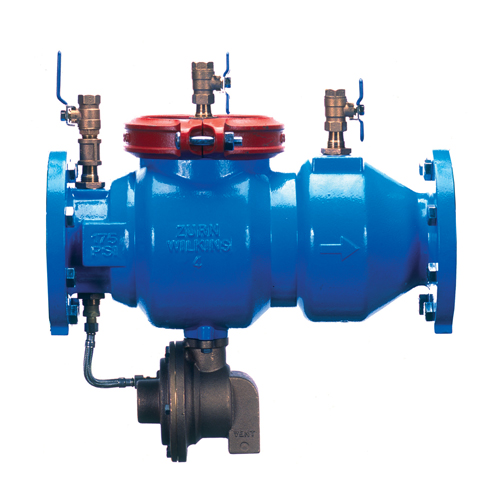RPZ Assembly (RPZ) Backflow Testing Prevention Device
What is RPZ Assembly?
RPZ assemblies (RPZ), also sometimes called a reduced pressure principle assembly, can prove to be the most secure and reliable of all backflow prevention devices. It protects the potable water system from contamination per the national plumbing codes. A RPZ assembly consists of an inlet shutoff valve, two independently operating spring- loaded check valves separated by a pressure differential relief valve, four test cocks, and an outlet shutoff valve.
How does it work?
The RPZ operates on the hydraulic principle, that is, the water will not flow from a zone of lower pressure to a zone of higher pressure. It is thus a differential-pressure valve in which the relief valve is held closed when the pressure in between two main check valves is lower than the pressure on supply-side by a prescribed amount. When the pressure falls on the supply side below the required value, the relief valve opens and the intermediate zone discharges to the surrounding atmosphere. Its installation can be done in irrigation, plumbing, waterworks, water digesters, laboratory equipment, car washes, commercial boilers, hospital equipment, main supply lines, and fire sprinkler. RPZ relief valve ideal operative pressure must remain at least 2 psi less than the supply pressure.
Features of RPZ Assembly
The RPZ Valve Assembly consists of two independently operating check valves as well as a hydraulically operated differential relief valve located below the first check valve. They are compatible with both above ground or below ground installation. Usually, the above-ground installation is more preferred. RPZs approve the chemigation process and thus are designed to protect water supplies from agricultural chemicals. It requires horizontal installation unless it is factory configured as per user demand for alternate installation. RPZs can be used in either backsiphonage or backpressure situations and is an acceptable means of protecting both against pollutants and contaminants.
How is it different than other Backflow Preventers?
RPZ consists of an automatic differential-pressure valve located between two or more independently acting, spring-loaded, resilient seat-check valves. Furthermore, these seat-check valves are located between two shut-off valves that are close together. For testing the tightness of the main check valves and ensuring the integrity of the whole system, there are test cocks provided with RPZs. When the situation demands an air gap in the backflow prevention system, RPZ is the best suited as it discharges to the atmosphere. Unlike other backflow assemblies, all system pressure is not lost as water flows through the RPZ assembly.

Why is RPZ the best for Backflow Prevention?
The RPZ has a unique design that allows it to dispose of any backward-flowing water if any check valves or relief valves fail. It thus can protect the public water supply quite eminently. There is some pressure loss through the assembly which no more than 13-20 psi. The RPZ has an outstanding over other rpz backflow preventers that it has a visible indication of any sort of malfunction long before the danger of backflow exists. Hence, this ensures that repairs can still be done when the device is already functioning and active. RPZ backflow device can ensure back- siphonage, backpressure, continuous pressure, and can be used in low hazard as well as high hazard situations.
We use RPZ devices that meet the requirements laid out by the AWWA Standard for Reduced- Pressure Principle Flow Water Out Backflow Prevention Assembly (AWWA C511-92) and approved by labs sanctioned by the Conference of State Sanitary Engineers. It is our mission to provide smart water backflow services and installation services to help solve all your backflow problems.
Call Us 732-735-9318 for rpz tester in New Jersey
